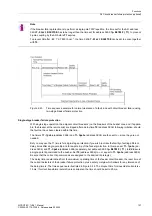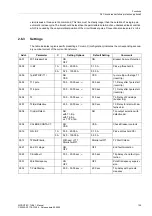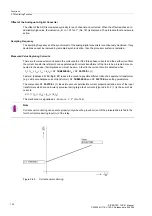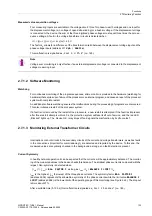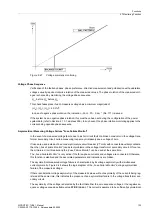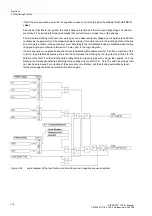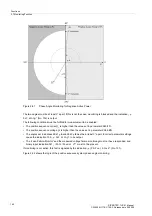
Functions
2.6 Circuit breaker failure protection (optional)
SIPROTEC, 7VK61, Manual
C53000-G1176-C159-3, Release date 05.2009
126
2.6.2
Setting Notes
General
The circuit breaker failure protection and its ancillary functions (end fault protection, pole discrepancy supervi-
sion) can only operate if they were set during configuration of the scope of functions (address
139
BREAKER
FAILURE
, setting
Enabled
or
enabled w/ 3I0>
).
Breaker failure protection
The breaker failure protection is switched
ON
or
OFF
at address
3901
FCT BreakerFail
.
The current threshold
I> BF
(address
3902
) should be selected such that the protection will operate with the
smallest expected short-circuit current. A setting of 10 % below the minimum fault current for which breaker
failure protection must operate is recommended. On the other hand, the value should not be set lower than
necessary.
If the breaker failure is configured with zero sequence current threshold (address
139
=
enabled w/ 3I0>
),
the pickup threshold for the zero sequence current
3I0> BF
(address
3912
) can be set independently of
I>
BF
.
Normally, the breaker failure protection evaluates the current flow criterion as well as the position of the breaker
auxiliary contact(s). If the auxiliary contact(s) status is not available in the device, this criterion cannot be pro-
cessed. In this case, set address
3909
Chk BRK CONTACT
to
NO
.
Two-stage Breaker Failure Protection
With two-stage operation, the trip command is repeated after a time delay T1 to the local feeder breaker, nor-
mally to a different set of trip coils of this breaker. A choice can be made whether this trip repetition shall be
single-pole or three-pole if the initial feeder protection trip was single-pole (provided that single-pole trip is pos-
sible). This choice is made in address
3903
1p-RETRIP (T1)
. Set this parameter to
YES
if the first stage is
to trip single-pole, otherwise set it to
NO
.
If the breaker does not respond to this trip repetition, the adjacent circuit breakers are tripped after T2, i.e. the
circuit breakers of the busbar or of the concerned busbar section and, if necessary, also the circuit breaker at
the remote end unless the fault has been cleared.
Separate delay times can be set
• for single- or three-pole trip repetition to the local feeder circuit breaker after a
1
-pole trip of the feeder pro-
tection
T1-1pole
at address
3904
,
• for three-pole trip repetition to the local feeder circuit breaker after
3
-pole trip of the feeder protection
T1-
3pole
(address
3905
),
• for trip of the adjacent circuit breakers (busbar zone and remote end if applicable)
T2
at address
3906
.
Note
In case of multi-phase tripping of the feeder protection,
T1-1pole
and
T1-3pole
are started in parallel.
T1-
3pole
therefore allows accelerating the tripping of the breaker failure protection compared to
T1-1pole
.
Therefore, you should set
T1-1pole
equal to or longer than
T1-3pole
.
The delay times are set dependant on the maximum operating time of the feeder circuit breaker and the reset
time of the current detectors of the breaker failure protection, plus a safety margin which allows for any toler-
ance of the delay timers. Figure 2-43 illustrates the timing of a typical breaker failure scenario. The dropout time
for sinusoidal currents is
≤
15 ms. If current transformer saturation is anticipated, the time should be set to
25 ms.
Summary of Contents for Siprotec 7VK61
Page 8: ...Preface SIPROTEC 7VK61 Manual C53000 G1176 C159 3 Release date 05 2009 8 ...
Page 14: ...Contents SIPROTEC 7VK61 Manual C53000 G1176 C159 3 Release date 05 2009 14 ...
Page 316: ...Literature SIPROTEC 7VK61 Manual C53000 G1176 C159 3 Release date 05 2009 316 ...
Page 328: ...Glossary SIPROTEC 7VK61 Manual C53000 G1176 C159 3 Release date 05 2009 328 ...
















